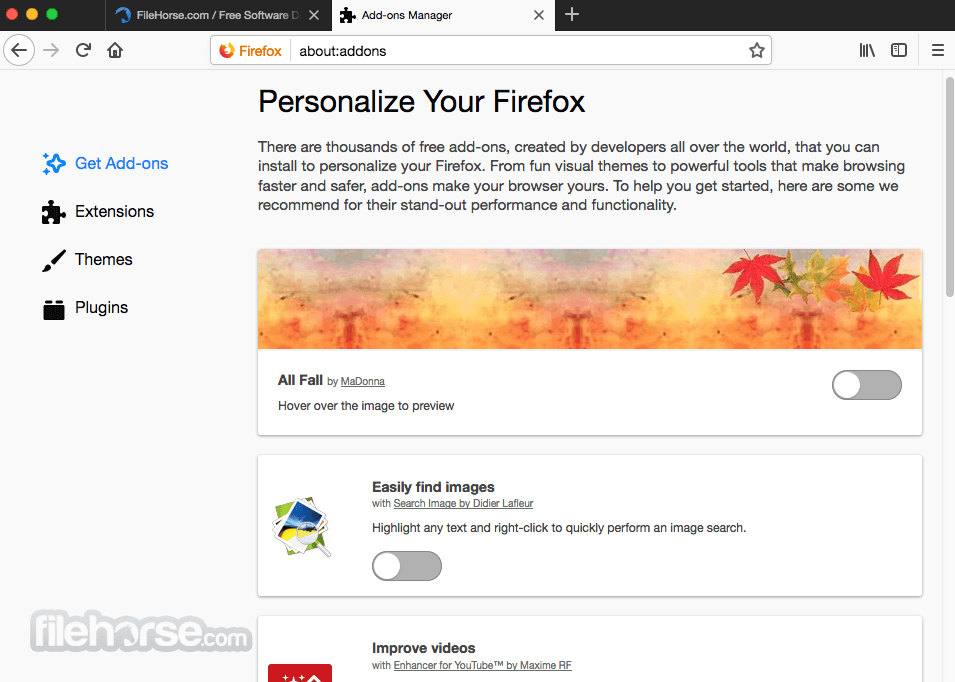
- #Firefox for mac 10.9 download full#
- #Firefox for mac 10.9 download verification#
- #Firefox for mac 10.9 download software#
- #Firefox for mac 10.9 download windows 7#
- #Firefox for mac 10.9 download free#
#Firefox for mac 10.9 download windows 7#
** Big Thanks to Greg’s comment, I used his method almost step by step… with only a few differences as noted below, as I’m using Windows 7 Home Premium SP1. At file prompt, select the “r” file downloaded in step 1. Right-click Certificates folder, select all tasks > import.ġ0. Navigate tree view: Certificates – Local Computer > Intermediate Certification Authorities > Certificates.ĩ. Find expired certificate “DST Root CA X3” in the table. I don’t think this is a problem, but I don’t understand it.ħ. Note: after import, it appears that there are duplicate entries for these – I see ISRG Root X1 and ISRG Root X2 each listed twice. Right-click on Certificates folder in the tree view, and select all tasks > import.ĥ. Look for ISRG ROOT X1 and ISRG ROOT X2.Ĥ. Navigate tree view: Certificates – Local Computer > Trusted Root Certification Authorities > Certificates. Open Windows Settings, search for ‘certificate’, select ‘manage computer certificates’ (requires elevation)ģ. DER versions of the 3 certificates listed above. Posting exact steps of what worked for me. So, I installed the certificates you linked into firefox, restarted it, and bingo, fixed. The long and the short of it is I was still having the problem in Firefox (two different versions on two different systems under different OS) though not on other browsers. The issue was Firefox (and, I assume, other browsers that do internal certificate management.). The reason I’m writing, other than to say thank-you, is because it was not the only needed step, and in case others have the issue, I want to describe it and the fix. This was on both Windows Vista and Windows 7.ĭownloading the three certificates you linked to, and then installing them via going to Internet Options (under networks and sharing) in the control panel was the first step in making my affected systems work again. It affected all browsers on my systems – even Firefox, which handles its own internal certificates. This issue affected me by preventing me from accessing some HTTPS sites. You, alone of all the pages I looked at, gave me clear help. I found your blog due to being hit by this issue and searching for answers. The steps should be similar for other firewalls that provide HTTPS Scanning and Filtering.ĩ9 Responses to “DST Root CA X3 Certificate Expiration Problems and Fix”
#Firefox for mac 10.9 download verification#

#Firefox for mac 10.9 download software#
Also, you may need to close and reopen any software and/or browsers for it to work with the new certificate. If you’re still having issues, you can try deleting the “DST Root CA X3” certificate from your existing Root CAs. The Let’s Encrypt certificates that are used on websites that you visit and that you might have deployed on your servers should now work without any issues. You only need to add the two root certificates.
#Firefox for mac 10.9 download full#
You can download them by clicking the links above or go to for more information and to download if you don’t trust the above links.Īfter downloading and adding these Root CAs and the Intermediate CA to your computer or device, you should have the full certificate chain to validate the Let’s Encrypt certificates. Let’s Encrypt R3 (Or Let’s Encrypt R3 DER Format).

#Firefox for mac 10.9 download free#
In my environment, I noticed a number of issues when browsing to websites that use the free Let’s Encrypt certificates, as the Web Protection Web Filtering service on my Sophos UTM firewall would report the certificate has expired and not allow me access to the websites using it. Some of these problematic devices include Samsung Galaxy phones, iPhones, VDI zero and thin clients, and even Sophos UTM firewalls. Today, the DST Root CA X3 certificate expired, leaving many devices on the internet having issues connecting to services and certificates that use this Root CA, including those using Let’s Encrypt certificates.


 0 kommentar(er)
0 kommentar(er)
